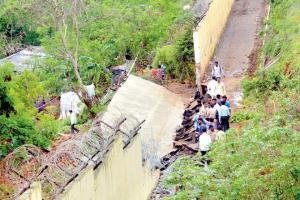The Malad wall collapse in July prompted the civic body to release funds that were being sought for the last three years by forest dept

The wall near Krantinagar, Malad had collapsed due to the force of the accumulated water flowing down from the adjoining forest area in the hilly region. File pic
The Malad wall collapse that killed 31 people and injured around 100 others has finally pushed the civic body to work on its rainwater harvesting project. The BMC is ready to release Rs 2 crore to the forest department to restrict flooding in the hilly parts of the city by investing in rainwater harvesting near Krantinagar and Lokhandwala areas in Kandivli as a pilot project. It can then be replicated in other hilly areas like Malad, Bhandup etc.
ADVERTISEMENT
Locals of Krantinagar have been hounding the forest department and BMC officials over the issue of flooding for the past three years. Water from the forest directly enters into the houses in the slums, they have claimed. Even after the BMC had promised, in a meeting held on March 2018 in the presence of state forest minister, to release funds for rainwater harvesting, the civic body has not disbursed funds yet.
The Malad wall collapse incident, where the force of accumulated water resulted in the loss of many lives, has finally pushed the civic body to release the funds. MLA Sunil Prabhu and local Shiv Sena corporator Vinaya Sawant had written to the BMC regarding the rainwater harvesting project near Krantinagar and Lokhandwala. "Every year the floodwater enters the slums. There is no nullah or gutter inside the forest which can carry the rainwater. We have been following up with the BMC for three years now. They have finally agreed," said Sawant.
The rainwater harvesting project will restrict the flow of water by recharging groundwater. The BMC will make provision for the funds from its 2019-20 budget and a proposal will be tabled in the standing committee meeting today.
How harvesting works
The concept is based on accumulation, storage and reuse of water. In cities, a storage tank is made by digging into the ground and water is released into it from building terraces. It requires structural work as opposed to the concept in villages or forest areas where water is collected directly by building a small stone wall (bandhara). The water collected above the ground, once groundwater is recharged, can be used directly.
Catch up on all the latest Crime, National, International and Hatke news here. Also download the new mid-day Android and iOS apps to get latest updates
 Subscribe today by clicking the link and stay updated with the latest news!" Click here!
Subscribe today by clicking the link and stay updated with the latest news!" Click here!






